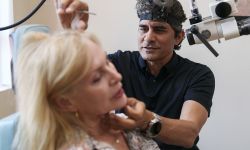Michigan tops U.S. in new COVID cases. Is it variants or just our turn?

June 30: Delta variant is increasing in Michigan, prompting coronavirus surge fears
June 17: Are your neighbors vaccinated? Michigan map shows rates by census tracts
April 26: As Michigan tamps down COVID, three new virus variants appear
A surge of new COVID-19 cases has Michigan’s rate growing faster than any other state. In one week alone, cases have jumped 50 percent to an average of nearly 3,700 per day.
The stunning rise has sparked school closures statewide and renewed calls for vigilance, even as Gov. Gretchen Whitmer has said she’s not considering any new restrictions.
But the increase comes after months during which Michigan weathered the pandemic better than most other states, with Whitmer’s administration pointing to its tough — and controversial — restrictions that limited business, schools and social gatherings.
Related:
- Whitmer may be right. Michigan may have turned the corner on COVID surge.
- Michigan at 'record high' for COVID-19 hospitalizations of children
- Demand for vaccine declines in parts of Michigan, even as COVID surges
- All is forgiven, Ohio*. Thanks for the COVID vaccine. Sincerely, Michigan.
- Teacher retirements soar in Michigan schools amid COVID pandemic
Now, as another wave of COVID-19 rips through Michigan, experts aren’t sure why cases are soaring here even as they are flat nationwide. But they have plenty of theories:
- Michigan let its guard down after Whitmer eased restrictions beginning Feb. 1 and schools reopened.
- Coronavirus variants stormed into the state.
- It’s Michigan’s time. Low overall infection rates for most of the pandemic left residents without natural immunity and created an opportunity for a resurgence.
“I think it’s a combination, to be honest,” said Dr. Matthew Sims, an infectious disease control expert with Beaumont Health in metro Detroit, which just last week enacted new limits on patient visitation because of a surge of COVID-19 patients.
Here are three main theories about what’s fueling the rise.
Theory No. 1: Virus variants
Across the hottest hotspots in Michigan — the Thumb and northern Michigan — public health and school officials blame the more contagious B.1.1.7 variant.
Michigan has the second-most cases from the variant in the nation, and genetic sequence has detected it in those regions. While testing is time-consuming and costly, experts say infections among students are occurring more easily, a hallmark of the B.1.1.7 variant first detected in the United Kingdom.
“Having seen it in action, we definitely know that it spread quickly,” said Jennifer Morse, medical director for three public health departments in central and northern Michigan which cover 19 counties.
In the Roscommon schools, Superintendent Catherine Erickson told Bridge Michigan that cases that once affected only one child are now affecting many more.
Officials in other parts of the state said the same: this surge seems to be more contagious.
Lisa Peacock, health officer for the Health Department of Northwest Michigan, said she has seen a jump in cases tied to schools, particularly student athletes and said the variant “is probably here more than we realize.”
Peacock noted that early predictions about the variant were that it would be the predominant strain by March.
“So I don’t think we’re surprised that it’s spreading,” she said.
In the last three weeks, infections among those 10 to 19 years-old have increased 117 percent, surpassed only by their parents’ demographic, those 40 to 49. Cases in that age group jumped 127 percent.
During this wave, those 10 to 19 comprise 17 percent of all infections, double the rate before the last three weeks.
The variants, if they were confined to Michigan, could help explain why the state is reporting such a stark rise in cases.
Beaumont’s Sims said he suspects the variants are playing a role in the increase in COVID-19 cases at the hospital. Younger people appear to be coming in worse shape than they were before and there is research indicating that B.1.1.7 can create worse symptoms and outcomes.
Theory No. 2: ‘Fertile ground’
Some are skeptical the variant alone is behind the surge.
“The variant is concerning, but it’s not driving the increase,” said Joshua Petrie, a research assistant professor in the department of epidemiology at the University of Michigan’s School of Public Health.
Instead, Petrie said Michigan may just be naturally “catching up to where other states are.”
Petrie said the state’s restrictions kept case counts lower than other states that had fewer forced closures of indoor dining and limits on face-to-face instruction.
Although Michigan has had over 16,000 people die from COVID-19 since the pandemic began, it had one of the lowest overall rates of infections per 100,000, ranking 43rd among all states.
That means that Michigan has one of the largest populations of people who do not have natural immunity, even though over 2.5 million people have received at least one dose of the coronavirus vaccines.
In other words, it’s “fertile ground” for a virus that is easily spread, Petrie said.
Indeed, many other states have had far higher rates of infection since the pandemic began, including all neighboring Great Lakes states. All of those states now have far lower current infection rates than Michigan.
Whitmer and public health officials hoped the restrictions would buy the state time to vaccinate as many as 5 million state residents — 70 percent of those 16 and older.
And in part, it has, with nearly two-thirds of people ages 65 and older — the most susceptible to a COVID-19 death — having at least started vaccination.
“The hope is we would get to higher vaccination coverage when this (surge) happened,” Petrie said.
As many as 100,000 people a day are now getting the vaccine, 20 times more than are getting infected as the state races toward herd immunity.
Theory No.3: Pandemic fatigue
Whatever the case, the virus wouldn’t spread as fast if people took normal precautions, said Sims, the Beaumont doctor.
But many are not. School officials are linking cases back to parties and outside-of-school gatherings, a sort of “spring fever.”
“There’s a lot of schools and people (who) kind of want to feel ‘now that we have some vaccines we should be able to get back to normal’,” said Stephanie Baker, emergency preparedness coordinator for Jackson County.
“And unfortunately, the virus didn’t just go away.”
Morse, the northern Michigan health director, said she has noticed a change in residents’ behavior: fewer masks, more large gatherings and angrier rhetoric about COVID restrictions.
Combine that with a variant that can spread faster in a crowd, she said, and you get “some doozies of outbreaks.”
Time to worry?
Whatever the reason for the increase, it shows no signs of abating — the state recorded over 5,000 new cases on Friday for the second consecutive day and over 10 percent of all tests in the past week came back positive.
The steady decline in deaths has stalled and hospitalizations are increasing as fast as they did in the fall.
Whitmer told a group on Thursday that she’s not considering any new restrictions, saying this increase is “different” because health officials know more about COVID-19 and the variants.
“When we did our pause in the fall, when everyone was seeing big increases, it worked,” Whitmer said. “We pulled back and dropped our numbers. We were about 3 percent positivity, one of the best in the country. And as we've brought things online, when we get up to 6 percent or up to 8 percent, those are alarming increases relative to where we were.
“But when you compare that to where other states already are, I think that's an important data point to look at too,” she said.
Michigan is now at 10 percent positive over the past week and only two other states — South Carolina and South Dakota — are worse.
Sims said that short of everyone being vaccinated, people need to remain vigilant because if the virus continues to flourish, there’s a greater chance that another mutation could occur that perhaps the vaccines cannot combat.
While the current coronavirus has a mortality rate lower than 2 percent, if it mutates into a more lethal virus, it could lead to far bigger problems that everyone will have to deal with.
“The more spread there is, the more cases there are, the more variants we’ll get,” Sims said. “People should be worried about it."
See what new members are saying about why they donated to Bridge Michigan:
- “In order for this information to be accurate and unbiased it must be underwritten by its readers, not by special interests.” - Larry S.
- “Not many other media sources report on the topics Bridge does.” - Susan B.
- “Your journalism is outstanding and rare these days.” - Mark S.
If you want to ensure the future of nonpartisan, nonprofit Michigan journalism, please become a member today. You, too, will be asked why you donated and maybe we'll feature your quote next time!








